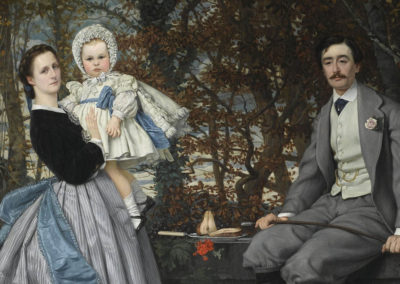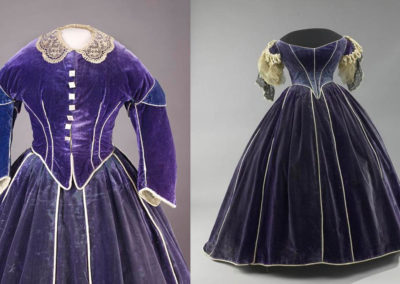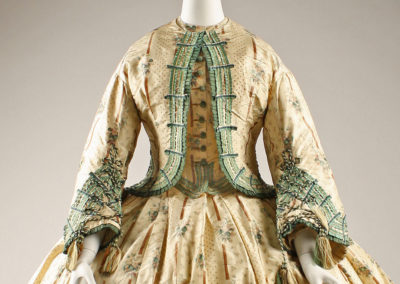OVERVIEW
In 1865 the shape of the crinoline had shifted—flattening in the front, with greater fullness in the back. Blue, neutral, and striped fabrics were quite popular and often accented with contrasting trimmings.
Womenswear
The year 1865 was a time still within the reign of the crinoline skirt. Sara Josepha Hale wrote in Godey’s Lady’s Book and Magazine (February 1865): “We are constantly questioned on the subject of crinoline—and frequently hear of its downfall, we see no diminution of it either in our late fashion plates, or in the promenades” (198). Le Follet writes similarly in April 1865: “The enemies of crinoline will yet have some time to wait before their ideas triumph. Skirts are made with as much train and as full as ever, and must have well-made crinolines to give them an air of elegance” (1). As Kimberly Chrisman-Campbell summed up in the Berg Encyclopedia of World Dress and Fashion (West Europe): “By the 1860s, the crinoline was elliptical, with a train, as it flattened in front and the bulk shifted to the back.” We can see evidence of crinolines in all the images as well as of the changed shape with a flatter front and longer back, especially in Fig. 4. In Fig. 11 it is very easy to see how much longer the skirt is in the back than in the front.
Fig. 1 - Designer unknown (American). Dress, ca. 1865. Silk. New York: The Metropolitan Museum of Art, C.I.69.33.8a. Gift of Mary Pierrepont Beckwith, 1969. Source: The Met
Fig. 2 - Designer unknown (American). Dress, ca. 1865. Cotton. New York: The Metropolitan Museum of Art, C.I.67.37.1. Gift of Mrs. John W. Mackay, 1967. Source: The Met
Fig. 3 - Claude Monet (French, 1840-1926). Lunch on the Grass, 1865-66. Oil on canvas; 248.7 x 218 cm. Paris: Musée d'Orsay, RF 1987 12. Source: Musée d'Orsay
Fig. 4 - Claude Monet (French, 1840-1926). Bazille and Camille, 1865. Oil on canvas; 93 x 68.9 cm (36 5/8 x 27 1/8 in). Washington: National Gallery of Art, 1970.17.41. Ailsa Mellon Bruce Collection. Source: NGA
Fig. 5 - Artist unknown. Peterson's Magazine, Les Modes Parisiennes, November 1865. New York: The Metropolitan Museum of Art. Gift of Woodman Thompson. Source: The Met
Color-wise, blue was a very popular color (Figs. 3, 4, 7, 12, 13). Le Follet writes in June 1865: “Plain light corn-flower blue appears to be the shade most in favor for foulard this season – either quite plain, or spotted with black spots, or striped with very fine black lines” (1). Neutral colors like those in Figs. 1, 2, 8, and 9 were also at a height of fashion. Le Follet wrote in March 1865: “there is no double that quite plain shades … will be the most in vogue” (1). Along with these two basic colors, contrasting bright trimmings were also very popular (Figs. 2, 5, 7, 13), as Le Follet wrote in June 1865: “The rage for bright trimmings is as great as ever” (1).
Fig. 6 - André-Adolphe-Eugène Disdéri (French, 1819-1889). Louis Revoil, February 1865–75. Albumen silver print from glass negative; 19.5 × 24.5 cm (7 11/16 × 9 5/8 in). New York: The Metropolitan Museum of Art, 2005.100.588.6. Gilman Collection, Gift of The Howard Gilman Foundation, 2005. Source: The Metropolitan Museum of Art
Fig. 7 - Eugène Boudin (French, 1824–1898). Princess Pauline Metternich (1836–1921) on the Beach, ca. 1865–67. Oil on cardboard, laid down on wood; 29.5 x 23.5 cm (11 5/8 x 9 1/4 in). New York: The Metropolitan Museum of Art, 1999.288.1. The Walter H. and Leonore Annenberg Collection, Gift of Walter H. and Leonore Annenberg, 1999, Bequest of Walter H. Annenberg, 2002. Source: The Met
Fig. 8 - Designer unknown (American). Evening dress, 1865. Silk. New York: The Metropolitan Museum of Art, 2009.300.6595. Gift of the Brooklyn Museum, 2009; Gift of Mrs. Harry Merrill, 1949. Source: The Met
Fig. 9 - Designer unknown (French). Dress, 1865. Silk. New York: The Metropolitan Museum of Art, C.I.69.33.11a–f. Gift of Mary Pierrepont Beckwith, 1969. Source: The Met
Fig. 10 - Designer unknown (British). Ensemble, ca. 1865. Silk. New York: The Metropolitan Museum of Art, 1983.27.1a–d. 1983.27.1a–d. Source: The Met
M
any of the dresses of the time also involved vertically striped fabric, such as the dresses in figures 6, 9, 10, and 11. Godey’s Lady’s Book and Magazine editor Sara Josepha Hale remarked on this in February 1865 saying:
“Beside the dress goods we have mentioned, are striped silk, broad satin and silk stripes woven alternately also embroidered silks, a large bouquet or design in each breadth. Some are elegantly and elaborately embroidered with jet beads and bugles. For evening wear, there are very rich satins striped with velvet.” (198)
Besides the classic silk for dresses, there was also an increase in the number of softer, more delicate fabrics used. There is evidence of this different fabrication in figures 1 and 2. Frank Leslie’s Lady’s Magazine and Gazette of Fashion reported in August 1865: “Light dresses of thin costly materials are to be seen more frequently than in former seasons, and are more expensively trimmed than ever” (89).
Looking at the dresses pictured, there are obvious similarities in silhouette apart from the crinoline skirt. For evening dresses, many of the necklines were very wide and off-the-shoulder with only very slight sleeves (Figs. 8-12, 13). This is different from the day dresses which had very high necklines and long semi-fitted sleeves (Figs. 1-7). Many of the dresses are belted at the waist (Figs. 1, 2, 5, 6, 9-11) and some bodices had pointed bottoms at center front, mostly in evening wear (Figs. 8, 10).
The dress painted in William Morris Hunt’s Olivia Buckminster Lothrop (Fig. 14) is well within the range of popular fashion for the 1865 woman. The skirt has the classic mid-1860s crinoline shape with the fullness slightly shifted to the back, characteristic of 1865. The bodice has the typical buttoned front and high neck of day dresses, with the long semi-fitted sleeves. The trim, belted sash, and bits of lace are also elements that are consistent with those popular in the year 1865.
Fig. 11 - Designer unknown (British). Evening dress, ca. 1865. Silk (probably), glass. New York: The Metropolitan Museum of Art, 2008.304a–c. Purchase, Allison Sarofim Gift, 2008. Source: The Met
Fig. 12 - Artist unknown. Peterson's Magazine, Les Modes Parisiennes, October 1865. New York: The Metropolitan Museum of Art. Gift of Woodman Thompson. Source: The Met
Fig. 13 - Artist unknown. La Mode Illustree, issue no 2, January 15, 1865. Source: Google Books
Fig. 14 - William Morris Hunt (American, 1824-1879). Olivia Buckminster Lothrop (Mrs. Lewis William Tappan, Jr.), mid–1860s. Oil on canvas; 158.8 x 84.5 cm (62 1/2 x 33 1/4 in). Boston: Museum of Fine Arts, 27.457. Source: Museum of Fine Arts Boston
Menswear
[To come…]
Fig. 1 - Artist unknown. Gentleman’s Magazine of Fashion. Plate 2., 1865. Private Collection. Source: Puddletown Bookshop
Fig. 2 - André-Adolphe-Eugène Disdéri (French, 1819-1889). Napoleon III and Empress Eugenie, ca. 1865. Albumen silver print; 9.5 x 6 cm (3 3/4 x 2 3/8 in). New York: The Metropolitan Museum of Art, 67.580.4.4. Gift of A. Hyatt Mayor, 1967. Source: The Metropolitan Museum of Art
Fig. 3 - Etienne Carjat (French, 1828-1906). Auguste Marc BAYEUX 1865; Francois BAZIN Composer 1865; BEAUVALLET 1865; Roger de BEAUVOIR 1865, 1865. Paris: Bibliotheque nationale de France. Source: Bibliotheque nationale de France
Fig. 4 - Edgar Degas (French, 1834-1917). Self-Portrait, 1865. Oil on canvas; 92.5 x 66.5 cm. Lisbon: Museu Calouste Gulbenkian, 2307. Jeanne Fèvre, niece of the artist, Nice. Acquired by Calouste Gulbenkian through André Weil in Paris on 28 October 1937. Source: Museu Calouste Gulbenkian
CHILDREN’S WEAR
Fig. 1 - Designer unknown (probably American). Ensemble, ca. 1865. Linen, cotton. New York: The Metropolitan Museum of Art, 1981.210.2a, b. Catharine Breyer Van Bomel Foundation Fund, 1981. Source: The Metropolitan Museum of Art
Fig. 2 - Laure Nöel (French, 1826-1878). Women 1865, Plate 085, 1865. New York: The Metropolitan Museum of Art. Gift of Woodman Thompson. Source: The Met
Fig. 3 - Jabez Hughes (English, 1819-1884). Princess Beatrice, 1865 [in Portraits of Royal Children Vol.9 1865], April 1865. Carbon print; 9.2 x 6.7 cm. London: Royal Collection Trust, RCIN 2901194. Source: Royal Collection Trust
Fig. 4 - Artist unknown (French). Journal des Demoiselles, December 1865. Hand-colored engraving. New York: FIT Library Special Collections and College Archives, Figure 104-US.NNFIT.SC.AP20.J76.1865. Source: FITDIL
References:
- “1865.” Wikipedia. Accessed on February 2, 2017. https://en.wikipedia.org/wiki/1865.
- Chrisman-Campbell, Kimberly. “France.” In Berg Encyclopedia of World Dress and Fashion: West Europe, edited by Lise Skov, 179-192. Oxford: Berg 2010. Accessed February 24, 2017.http://dx.doi.org/10.2752/BEWDF/EDch8036a.
- Hale, Sara Josepha. “Chitchat upon New York and Philadelphia: Fashions for February.” Godey’s Lady’s Book and Magazine. (February 1865): 198. https://babel.hathitrust.org/cgi/pt?id=mdp.39015004111103;view=1up;seq=208
- “La Mode.” Le Follet 19, 223. (April 1865): 1. https://books.google.com/books?id=dh0GAAAAQAAJ&pg=PA282#v=onepage&q&f=false
- “La Mode.” Le Follet 19, 225. (June 1865): 1. https://books.google.com/books?id=dh0GAAAAQAAJ&pg=RA1-PA559#v=onepage&q&f=false
- “La Mode.” Le Follet 19, 222. (March 1865): 1. https://books.google.com/books?id=dh0GAAAAQAAJ&pg=PA121#v=onepage&q&f=false
- Tétart-Vittu, Françoise, and Gloria Groom. “Key Dates in Fashion and Commerce, 1851-89.” In Impressionism, Fashion, & Modernity, ed. Gloria Groom, 273. New Haven: Yale University Press, 2012.
- “What Should Be Worn, and What Should Not.” Frank Leslie’s Lady’s Magazine and Gazette of Fashion XVII, 2. (August 1865): 89. https://babel.hathitrust.org/cgi/pt?id=nyp.33433103958397;view=1up;seq=83
Historical Context
Wikipedia: 1865
Rulers:
- America:
-
- President Abraham Lincoln (1861-65)
- President Andrew Johnson (1865-69)
- England: Queen Victoria (1837-1901)
- France
- Emperor Napoleon III (1852-70)
- Spain
- Queen Isabel II (1833-68)
Europe 1867. Source: Omniatlas
Events:
- April 14 – Abraham Lincoln assassinated (Wikipedia)
- May 9 – End of the American Civil War (Wikipedia)
- May 11 – “Jules Jaluzot (1834–1916) launches the department store Au Printemps at the corner of boulevard Haussmann and the rue de Provence (fig. 8). He is the first to sell an exclusive black silk for dresses known paradoxically as ‘Marie-Blanche.'” (Tétart-Vittu 273)
Primary/Period Sources
Resources for Fashion History Research
To discover primary/period sources, explore the categories below.
Have a primary source to suggest? Or a newly digitized periodical/book to announce? Contact us!
Fashion Plate Collections (Digitized)
- Costume Institute Fashion Plate collection
- Casey Fashion Plates (LA Public Library) - search for the year that interests you
- New York Public Library:
NYC-Area Special Collections of Fashion Periodicals/Plates
- FIT Special Collections (to make an appointment, click here)
- Englishwoman's Domestic Magazine (London: 1852-79), 1860-64, 1867-69 (TT500 .E6)
- Costume Institute/Watson Library @ the Met (register here)
- New York Public Library
- Brooklyn Museum Library (email for access)
Womenswear Periodicals (Digitized)
Etiquette Books (Digitized)
Menswear Periodicals / Etiquette Books (Digitized)
Secondary Sources
Also see the 19th-century overview page for more research sources... or browse our Zotero library.









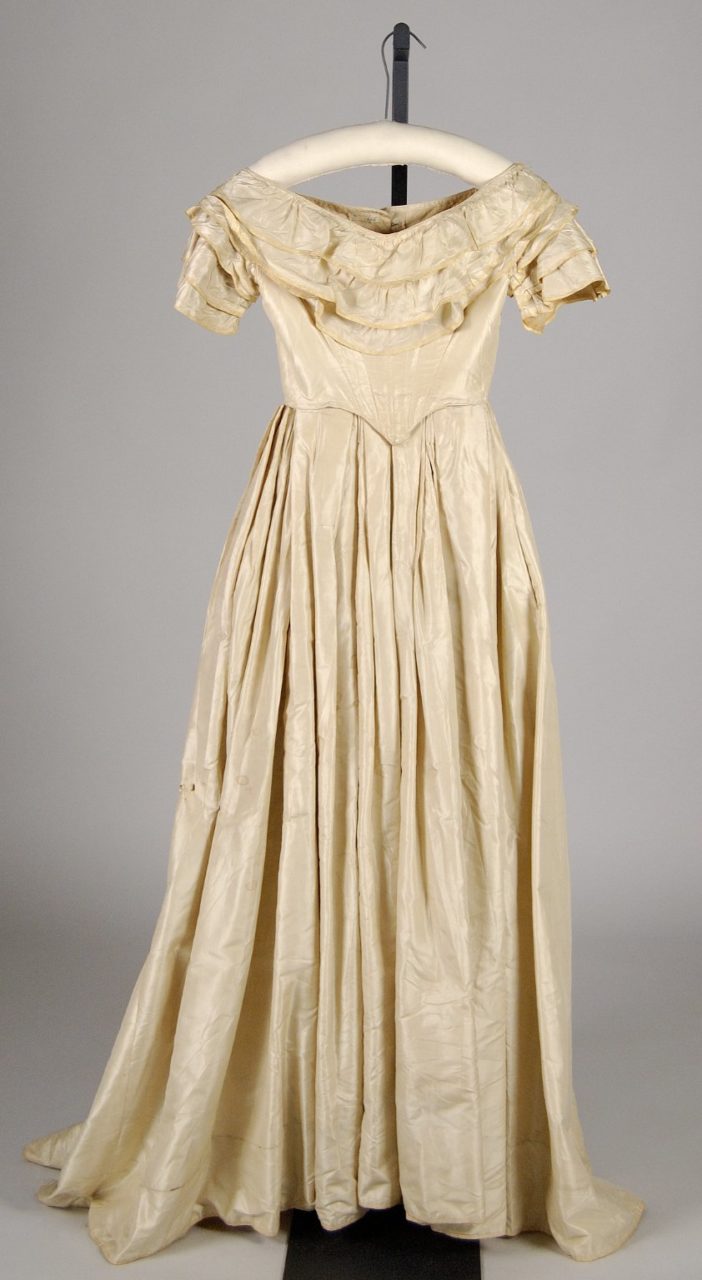




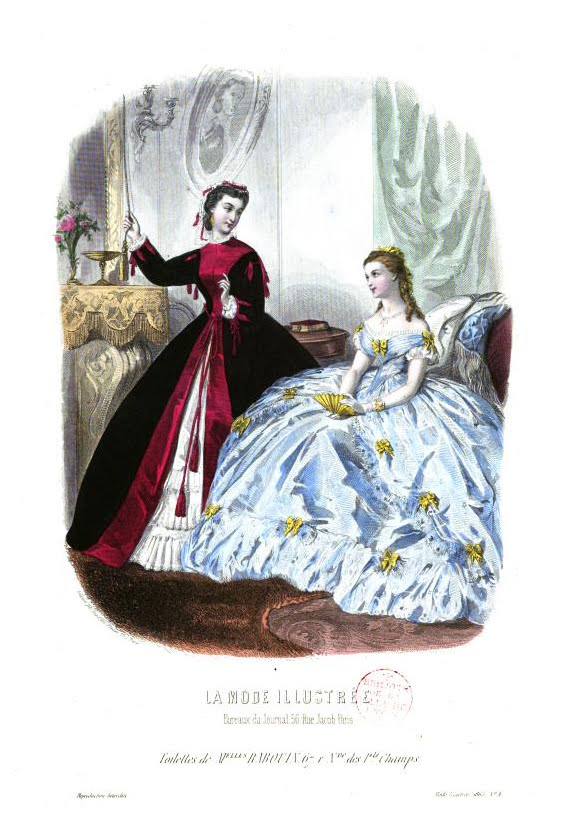







![Princess Beatrice, 1865 [in Portraits of Royal Children Vol.9 1865] Princess Beatrice, 1865 [in Portraits of Royal Children Vol.9 1865]](https://fashionhistory.fitnyc.edu/wp-content/uploads/2017/09/1865-Childrenswear-03.jpg)




